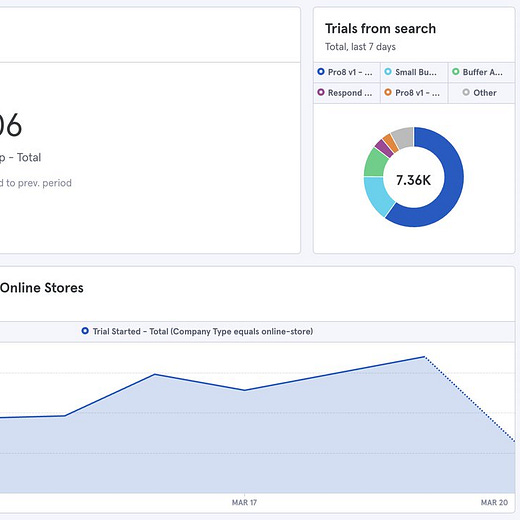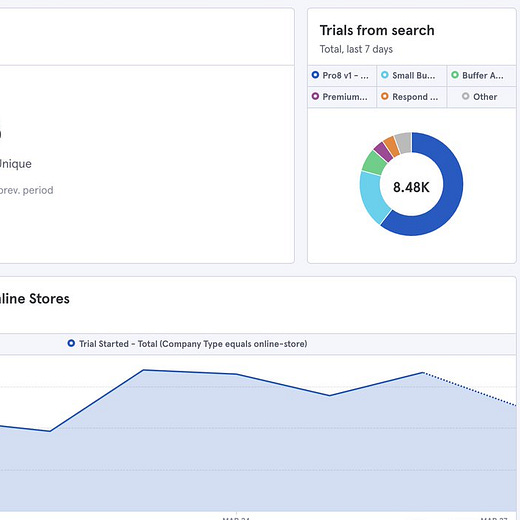Forward →
Ways to approach marketing strategy and teammate support. Plus, favorite playlists.
👋Hi there! I share a weekly update on ways to be a better marketer, brand-maker, team-builder, and person. If you enjoy this, you can share some love by hitting the Substack heart button above or below.
Hi.
How are you?
Is there anything I can do to help?
Like last week, I’ve put together a list of some marketing and management ideas — stuff we’re thinking about and talking about at Buffer. Plus, I’ve included some lighter stuff that brings me joy; this week, Spotify playlists.
I hope you find something valuable or interesting or positive here.
Please do reach out anytime with a reply to any of these emails or a message at hello@kevanlee.com.
Thinking of you,
Kevan
❶
Notes on marketing strategy
How to navigate turbulent times. Are you adapt or endure?
Here is a snapshot of how things are going at Buffer with two of our key acquisition indicators. The images are week-over-week views from the past two complete weeks:
We are fortunate in many ways — we are a B2B software product for social media teams. Social media matters quite a lot right now. When it comes to marketing data today, as I’m sure you know, experiences vary wildly across industries and business models and customer segments, but I hope it’s helpful to see a little taste of some real data of what we’re experiencing.
Ask me any questions about the above, and I’m happy to go into more detail.
Along with looking at the data, I’ve spent the past week reading as widely as possible, talking to teammates, and seeking advice from others in my network. Special thanks to the Reforge community for the wisdom they’ve shared.
Here are some of the things top of mind from those conversations and sessions.
1. What worked two weeks ago will not work today.
You have to throw your previous customer problems and definitions out the window.
You might have to throw a lot out the window, honestly. Review all your existing marketing messaging on emails, landing pages, ads, etc. and remove anything that feels insensitive to the current moment.
Now is the time to be re-evaluating your customer personas and key messaging.
Here is the process I’ll be recommending to my team:
Experiment with a handful of new value props by testing the copy on social ads and email messages.
Put the winning messages in the H1s of landing pages
One of the first tests I’m interested to try: The value prop of “we cost less” might be vastly more appealing now than it was two weeks ago.
2. Churn is a lagging indicator
If you wait to act until churn increases, it’s too late.
Monitoring churn is a great idea so long as you’re monitoring usage along with it.
People take a long time to churn, which makes churn a very lagging indicator. Instead of looking at the final churn event, look earlier in your customer’s behavior: How are they using the product? Which behaviors show an active, engaged user and which behaviors show a user about to churn?
At Buffer, we can monitor things like WAUs, posts sent, or analytics viewed. These tell us how usage and activity are evolving.
Ways to get ahead of churn:
Monitor key usage metrics
Shore up mechanical churn: payment failures, contracts ending
Consider offering bundles, discounts (“two months free”), or additional product functionality
Some of the best advice I’ve heard is about being relentlessly focused on customer retention — which coincidentally is the inverse of churn.
Focus on leaving the period with as many paid customers as possible. Trade ARPU / ACV / baselines in exchange for that.
This is an interesting one for us at Buffer because one of our key goals right now is to increase ARPU. But we might need to evolve this. You see companies like Loom cutting prices in order to help greater numbers of people. Especially for those companies who are on strong financial footing, lowering prices and lowering barriers of entry into their product can be a huge benefit to customers who are more price-conscious and uncertain than ever. Even things like 90-day trials (90 days!) are in vogue.
3. How to model your next 30 days
Interestingly, about all you can model is 30 days at this point. All previous benchmarks and historical data is somewhat useless. Because of this, here is the simple forecast that was recommended to me:
Set a baseline scenario, a bad scenario, and a worse scenario.
Baseline is the old conservative levels you previously were aiming for. It’s going to be hard to hit that baseline now unless you’re in a unique vertical.
For the bad scenario, bring down your baseline by 20%.
For the worse scenario, bring down your baseline by 40%.
This will at least give some element of science to how you’re forecasting and monitoring the coming weeks. Then, when April ends, you can see where things are and adjust the numbers again.
4. The #1 regret from leaders in turbulent times is that they did not change strategy and messaging fast enough.
I shared this last week in the newsletter. It’s one of the key pieces of advice for brand and crisis strategy from NYU’s brand course.

Overcorrecting feels especially relevant. At times like these, it is okay to react more quickly and with more intuition than you normally would. Be lean, be experimental. Forget what you know! Test quickly and then go for it.
Overreacting is okay. Under-reacting is so much worse.
❷
Notes on supporting your team
In previous newsletters, I’ve mentioned the concept of BICEPS, a framework that identifies the six core needs that must be met for people to feel safe and secure.
As you can probably tell, these core needs carry extra significance during turbulent times. Here are each of the six BICEPS needs:
Belonging: This core need is about a sense of belonging, a connection to a community or to a group of people. Our amygdala perceives social rejection as a threat.
Improvement/Progress: We have a core need to feel some level of improvement, or a sense of making progress—whether for your organization, for your team, or for your personal life.
Choice: Choice (or autonomy) is the power to make decisions about your own life and work. This core need calls for balance— too many choices can feel overwhelming or aimless; too few choices can make you feel powerless.
Equality/Fairness: This core need boils down to the idea that your environment includes equal access to resources, information, and support for everyone in it.
Predictability: We need the right balance of consistency and unpredictability in our lives to thrive. When our sense of certainty is threatened, we may have a really hard time focusing on our job duties or goals.
Significance: Significance, or status, is our core need for understanding where we are in a hierarchy, especially in relation to others.
Do you recognize your core need right now?
Can you find out what your teammates might be needing at this moment?
In the coming days, I’m going to try to reorient my people management around identifying some of these needs for me and my team (thank you to my teammates Courtney & Katie for the tip). It’s a pretty straightforward process: Show a teammate the list, ask them about their core need, then brainstorm together how to help meet that need, to the best of your abilities. :)
❸
Favorite playlists
If you’re looking for some new tunes to play for WFH, here are some of the playlists that I turn to most often:
Relaxing surf jams:
Spotify’s Have a Great Day playlist:
Favorite songs, heard on TikTok:
Need for Speed (the video game) playlist:
And for anyone with little kids at home:
Thanks so much for reading. Wishing you a good week.
— Kevan
P.S. If you liked this email and have a quick moment, could you click the heart button below? It’d mean a ton to me and might help surface this newsletter for others. Thank you!






I can't believe I missed the BICEPS framework previously! It reminds me of the saying, "People don't quit jobs, they quit bosses." Every time I have changed roles in my career has been due to a BICEPS tear, or from another organization offering a better BICEPS pump. 💪 Training the BICEPS keeps them strong :)